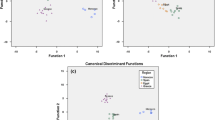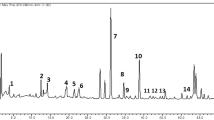Abstract
The aim of the present study was to differentiate Greek thyme honeys according to geographical origin, based on phenolic compound content and conventional physicochemical parameters using MANOVA and Linear Discriminant Analysis. Thirty-five thyme honey samples were collected during the harvesting period 2011 from four different regions in Greece (Irakleio, Hania, Kefalonia and Lakonia) known to produce thyme honey of good quality. The analysis of phenolic compounds (quercetin, myricetin, kaempferol, chrysin, and syringic acid) was performed by high pressure liquid chromatography. Conventional quality parameter analysis included the determination of the following: pH, free, lactonic and total acidity, electrical conductivity, moisture, ash, as well as lactonic/free acidity ratio and colour parameters L*, a*, b*. Using five phenolic compounds and 11 conventional quality parameters, thyme honey samples were satisfactorily classified (91.2 % correct prediction) according to geographical origin.



Similar content being viewed by others
References
Acquarone C, Buera P, Elizalde B (2007) Pattern of pH and electrical conductivity upon honey dilution as a complementary tool for discriminating geographical origin of honeys. Food Chem 101:695–703
Al LM, Daniel D, Moise A, Bobis O, Laslo L, Bogdanov S (2009) Physicochemical and bioactive properties of different floral origin honeys from Romania. Food Chem 112:863–867
Alissandrakis E, Tarantilis PA, Harizanis PC, Polissiou M (2007) Comparison of the volatile composition in thyme honeys from several origins in Greece. J Agric Food Chem 55:8152–8157
Al-Mamary M, Al-Meeri A, Al-Habori M (2002) Antioxidant activities and total phenolics of different types of honey. Nutr Res 22:1041–1047
AOAC Official methods of analysis, 15th ed.; Helrich, K., Ed.; Association of Official Analytical Chemists Inc.: Arlington, VA, 1990; Methods 954.11–979.21 and 977.20, pp 1028–1030
Azar M, Verette E, Brun S (1987) Identification of some phenolics compounds in Bilberry Juice Vaccinium myrtillus. J Food Sci 55:1255–1257
Baroni MV, Nores ML, Díaz MDP, Chiabrando GA, Fassano JP, Costa C, Wunderlin DA (2006) Determination of volatile organic compound patterns characteristics of five unifloral honeys by solid-phase microextraction—gas chromatography-mass spectrometry coupled to chemometrics. J Agric Food Chem 54:7235–7241
Beretta G, Granata P, Ferrero M, Orioli M, Maffei Facino R (2005) Standardization of antioxidant properties of honey by a combination of spectrophotometric/fluorimetric assays and chemometrics. Anal Chim Acta 533:185–191
Council Directive 2001/110/EC relating to honey. Official J Eur Communities L 10/47-L 10/52
Council Regulation (EC) No.510/2006 on the protection of geographical indications and designations of origin for agricultural products and foodstuffs. Official J Eur Union C302–C324 (6/10/2012)
Directive127/2004. Classification of monofloral honeys. Greek Ministry of Agricultural and Food Development, 67a Codex Alimentarius
Escuredo O, Fernández-González M, Carmen SM (2012) Differentiation of blossom honey and honeydew honey from Northwest Spain. Agriculture 2:25–37
Ferreira Isabel CFR, Edmur A, Barreira Joao CM, Estevinho Leticia M (2009) Antioxidant activity of Portuguese honey samples: different contributions of the entire honey and phenolic extract. Food Chem 114:1438–1443
Ferreres F, Andrade P, Tomás-Barberán FA (1994) Flavonoids from Portuguese heather honey. Z Lebens Unter Forsch 199:32–37
Ferreres F, Andrade P, Tomás-Barberan FA (1996) Natural occurrence of abscisic acid in heather honey and floral nectar. J Agric Food Chem 44:2053–2056
Field A (2009) Discovering statistics using SPSS, 3rd edn. Sage Publications, London, p 384
Gheldof N, Wang XH, Engeseth NJ (2002) Identification and quantification of antioxidant components of honeys from various floral sources. J Agric Food Chem 50:5870–5877
González-Miret ML, Terrab A, Hernanz D, Fernández-Recamales MA, Heredia FJ (2005) Multivariate correlation between color and mineral composition of honeys and by their botanical origin. J Agric Food Chem 53:2574–2580
Harmonized methods of the International Honey Commission (IHC), (1997). IHC responsible for the methods: Stefan Bogdanov. Swiss Bee Research Centre FAM, Liebefeld, CH-3003 Bern, Switzerland.
Kassim M, Achoui M, Mohd Rais M, Ali Mohd M, Kamaruddin MY (2010) Ellagic acid, phenolic acids, and flavonoids in Malaysian honey extracts demonstrate in vitro anti-inflammatory activity. Nutr Res 30:650–659
Kenjerić D, Mandić ML, Primorac L, Bubalo D, Perl A (2007) Flavonoid profile of Robinia honeys produced in Croatia. Food Chem 102:683–690
Louveaux J, Maurizio A, Vorwohl G (1978) Methods of melissopalynology. Bee World 51:125–131
Malika N, Mohamed F, Chakib EA (2005) Microbiological and physicochemical properties of Moroccan honey. Int J Agric Biol 5:773–776
Marchini LC, de Camargo AC, Moretti C, Otsuk IP, Sodré S (2007) Physicochemical composition of Apis mellifera honey samples from São Paulo State, Brazil. Quim Nova 30:1653–1657
Martos I, Cossentini M, Ferreres F, Tomás-Barberán FA (1997) Flavonoid composition of Tunisian honeys and propolis. J Agric Food Chem 45:2824–2829
Michalkiewicz A, Biesaga M, Pyrzynska K (2008) Solid-phase extraction procedure for determination of phenolic acids and some flavonols in honey. J Chromatogr A 1187:18–24
Nasuti C, Gabbianelli R, Falcioni G, Cantalamessa F (2006) Antioxidative and gastroprotective activities of anti-inflammatory formulations derived from chestnut honey in rats. Nutr Res 26:130–137
Sanz S, Perez C, Herrera A, Sanz M, Juan T (1995) Application of a statistical Approach to the Classification of Honey by Geographic origin. J Sci Food Agric 69:135–140
Senyuva HZ, Gilbert J, Silici S, Charlton A, Dal C, Gürel N, Cimen D (2009) Profiling Turkish honeys to determine authenticity using physical and chemical characteristics. J Agric Food Chem 57:3911–3919
Soria AC, González M, de Lorenzo C, Martínez-Castro I, Sanz J (2004) Characterization of artisanal honeys from Madrid (Central Spain) on the basis of their melissopalynological, physicochemical and volatile composition data. Food Chem 85(1):121–130
Terrab A, Recamales AF, Hernanz D, Heredia FJ (2004) Characterisation of Spanish thyme honeys by their physicochemical characteristics and mineral contents. Food Chem 88:537–542
Thrasyvoulou A, Manikis J (1995) Some physicochemical and microscopic characteristics of Greek unifloral honeys. Apidologie 26:441–452
Tsiapara AV, Jaakkola M, Chinou I, Graikou K, Tolonen T, Virtanen V, Moutsatsou P (2009) Bioactivity of Greek honey extracts on breast cancer (MCF-7), prostate cancer (PC-3) and endometrial cancer (Ishikawa) cells: profile analysis of extracts. Food Chem 116:702–708
Vinson JA, Hao Y, Su X, Zubik L (1998) Phenol antioxidant quantity and quality in foods: vegetables. J Agric Food Chem 46:3630–3634
Viuda-Martos M, Ruiz-Navajas Y, Fernández-López J, Pérez-Álvarez JA (2008) Functional properties of honey, propolis, and royal jelly. J Food Sci 73:117–124
Wahdan HAL (1998) Causes of the antimicrobial activity of honey. Infection 26:30–35
White JW (1975) Physical characteristics of honey. In: Crane E (ed) Honey, a comprehensive survey (pp. 207–239). Heinemann, London, UK
White JW Jr, Riethof ML, Subers MH, and Kushnir I (1962) Composition of American honeys. Eastern Utilization Research and Development Division, Agricultural Research Service, Philadelphia, Pa. Technical Bulletin No.1261. Washington, DC
Yaoa L, Jiang Y, Singanusong R, Datta N, Raymont K (2005) Phenolic acids in Australian Melaleuca, Guioa, Lophostemon, Banksia and Helianthus honeys and their potential for floral authentication. Food Res Int 38:651–658
Acknowledgments
The authors are grateful to Attiki honey S.A, Athens, Greece, Dr. Sofia Karabournioti and to local beekeepers from Lakonia, for the donation of honey samples. We thank associate professor K.A. Riganakos for the donation of pure syringic acid. Excellent technical assistance of Ms. Evangelia Halatsi is also greatly acknowledged.
Conflict of Interest
Ioannis Karabagias declares that he has no conflict of interest. Maria Vavoura declares that she has no conflict of interest. Anastasia Badeka declares that she has no conflict of interest. Stavros Kontakos declares that he has no conflict of interest. Michael Kontominas declares that he has no conflict of interest. This article does not contain any studies with human or animal subjects.
Author information
Authors and Affiliations
Corresponding author
Rights and permissions
About this article
Cite this article
Karabagias, I.K., Vavoura, M.V., Badeka, A. et al. Differentiation of Greek Thyme Honeys According to Geographical Origin Based on the Combination of Phenolic Compounds and Conventional Quality Parameters Using Chemometrics. Food Anal. Methods 7, 2113–2121 (2014). https://doi.org/10.1007/s12161-014-9851-5
Received:
Accepted:
Published:
Issue Date:
DOI: https://doi.org/10.1007/s12161-014-9851-5




